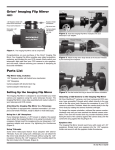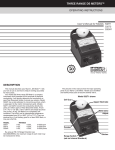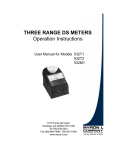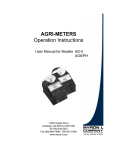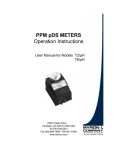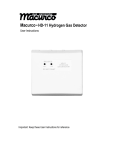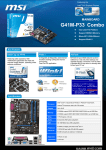Download 4&5 RANGE CONDUCTIVITY METERS
Transcript
4&5 range conductivity meters operating instructions User’s Manual for Models EP EP-10 description This manual describes your Myron L EP series meter, tells you how to use it, and how to keep it working accurately for many years. Myron L EP & EP10 Meters are compact, multi-range instruments which operate on the principle of electrical conductivity. They each contain a built-in cell cup and will quickly determine the conductivity of almost any solution. Both have dials calibrated in micromhos (µmhos) equivalent to the metric microsiemens (µS). Model EP features a second dial scale calibrated in megohms/resistivity for testing ultrapure water. Both are 3.4” x 4.5” x 4.0” (86 x 114 x 102mm) and weigh less than one pound (0.45 kg). EP series meters are completely self-contained. The built-in cell is automatically temperature compensated. They are powered by one 9 volt battery good for at least 2000 tests, or one year shelf life. By using an RE-10 Range Extender (see accessories), the maximum range of each meter may be increased ten times. The pictures in this manual show the major operating parts of your Myron L EP series meter. Handle your meter and identify these parts to become familiar with it. Cell Cup Model EP10 shown Upper Electrode model ranges EP EP10 0-0.5, 0-5, 0-50, 0-500, 0-5,000 micromhos (µmhos) 2-30 Megohms 0-10, 0-100, 0-1,000, 0-10,000 micromhos (µmhos) Meter Zero Adjust accuracy: (Both Models) ±2% of full scale repeatability: (Both Models) ±1% Battery Indicator temperature compensation to 25ºC: EP EP10 32-120ºF (0-49ºC) 50-160ºF (10-71ºC) Pointer Range Switch Button using your meter 1. 2. Turn the Range Switch to the desired range. If you don’t know which range to use, set it to 1000. Rinse the cell cup three times with the sample you want to test. (For very hot or very cold samples see temperature compensation below.) never fill the cell by dipping the meter into water! 3. Fill the cell with another sample to at least 1/4” (6mm) above the upper electrode. 4. Press the black button. 5. Read the dial’s black scale value indicated by the pointer. If the pointer is very low on the left or goes off the scale to the right, try the next lower or higher range. 6. Multiply the dial’s black scale value by the range setting to determine conductivity in micromhos (microsiemens). 7.If the pointer goes off the scale to the right on the x1000 range, use an RE-10 range extender (see accessories). note: When you are finished with the meter, rinse the cell cup with clean water, preferably distilled or deionized. temperature compensation: For very hot or very cold solutions, let the three rinse samples each remain in the cell for several seconds. Then immediately fill the cell with the sample you want to test (step 3 above). This allows the automatic temperature compensation feature time to work properly. resistivity measurement: Model EP only. Accurate measurement of high purity water is difficult even under controlled conditions. Water temperature and even carbon dioxide (CO2) in the atmosphere will greatly influence MODEL EP resistivity. Use the following methods for best accuracy: 1. Turn the range switch to the x.1 range (with the “Ω” symbol around it). 2. Hold your meter close to the high purity water outlet. While pressing the button, allow the water to flow into the Cell Cup and out again, continuously purging the cell. Do not allow air bubbles to collect. 3.As the cell is washed clean of trace contamination, the reading will drop and eventually stabilize. Read the resistivity directly in megohms on the red scale. do not multiply the dial reading by the range switch value. note: The closer the tested water temperature is to 25ºC (77ºF), and the less it is exposed to air, the more accurate your reading will be. caution Always rinse the cell cup with pure water immediately after use or cleaning. This will prevent the build-up of unwanted deposits and possible contamination of the next sample. do not use with samples hotter than specified. The readings will not be accurate. do not splash solvents such as lacquer thinner, acetone, benzene or chlorinated solvents on the plastic case. do not fix or modify the meter. That will void your warranty. See service for details or consult Myron L Company do not dip the instrument into water. If water does get inside the instrument, see maintenance for instructions on drying it. MODEL EP10 calibration/maintenance standard solutions: A Standard Solution has a known conductivity and ppm. Your meter was calibrated at the factory using NIST Standard Solutions. You can keep your meter accurate by using the same NIST Standard Solutions. To pick the right Myron L Company Standard Solution for your meter see accessories. How often you calibrate your meter depends on how much you use it. For once a day use, recalibrate it every three months. checking calibration 1. Turn the Range Switch to the x1000 range. 2. Test a sample of appropriate Standard Solution. caution: Throw the Standard Solution away as you use it. Don’t put the used samples back in the bottle. 3.If the meter does not indicate the same value as is on the Standard Solution bottle’s label, first clean the cell. For directions on how to do this see cell cup. Rinse the cell thoroughly and test the Standard Solution again. If the meter still does not indicate the correct value, recalibrate it as described below. to recalibrate the meter 1. Remove the bottom cover using fingernails or a small screwdriver to loosen the front or rear edge. Identify the Calibration Control (see photo below) so you can find it by touch while calibrating. 2. Test another sample of the Standard Solution (be careful to not splash solution inside the meter). 3.Adjust the Calibration Control until the meter indicates the value that is on the Standard Solution label. Battery Strap Lower Electrode (inside cell) accessories This ensures consistent results each time. With some samples a small downward swing of the pointer is a result of this conditioning action. This action is powerful and removes normal films of oil and dirt. However, if very dirty samples — particularly scaling types — are allowed to dry in the cell cup, a film will build up. This film reduces accuracy. When there are visible films of oil, dirt or scale in the cell cup or on the electrodes, scrub them lightly with a small brush and household cleanser. Rinse out the cleanser and the meter is ready for accurate measurements. water inside the meter Your Myron L EP meter is a rugged instrument and will withstand water exposure around its cell, meter movement, and switches. However, care should be taken to keep water from leaking in around the bottom cover. It is not sealed (to prevent condensation from forming). If water is relatively clean (i.e., tap water or better), and there are only a few drops inside the meter, dry it as described below. Large amounts of water, or corrosive or very dirty solutions will almost certainly damage the meter movement or electronics. Such meters should be returned to the Myron L Company for repair. To dry your meter: 1. Shake excess water out of the inside of the meter. 2. Dab the exposed surfaces dry with an absorbent cloth or tissue. Avoid pushing any water into the Calibration Control or switches. 3.Air dry the meter in a warm area with the bottom cover off. Allow several hours for thorough drying. If the water entered through a leak in the case or cell, or if the instrument shows erratic readings or other unusual behavior, return it to the Myron L Company for servicing. warranty/service Myron L EP and EP10 Meters have a limited two year warranty. If your instrument fails to operate properly, check the battery and calibration. If it still fails to function properly, return it prepaid to the Myron L Company. Faulty instruments may be returned to us without prior permission. meters within two year warranty period: Failures due to materials or workmanship will be repaired or replaced (our option) without charge if returned freight prepaid. If failure is deemed by the factory to have been caused by abuse or tampering, the following procedure will apply. Calibration Control maintenance battery check Models EP and EP-10 have a battery indicator glow light visible through the small hole on the lower right-hand corner of the meter face plate. If this light fails to glow when the black button is pressed, replace the battery. battery replacement To replace the battery detach the battery connector. Pull on the plastic strap to remove the battery. Replace with fresh zinc carbon or alkaline 9 volt battery. Reinsert the plastic strap to secure battery. cell cup Self-conditioning of the built-in electrodes occurs each time the button is pressed with a sample in the cell cup. instruments/controls out of warranty: Diagnosis will be made and repairs completed providing the repair charges are $90.00 or less. note: Actual repair charges may be less than this amount. We will diagnose (but not repair) a returned meter and fax an estimate of charges if any of the following apply: 1. Repair charges will be more than $90.00. 2. You specifically request an estimate of required repairs and charges. 3. The cost of required repairs exceeds one-half the list price of a new instrument. 4. The instrument is over ten years old. Because of component changes and improvements, such instruments can no longer be repaired. note: Unrepaired meters are discarded unless you want them returned to you. If so, there is currently a $35.00 charge per unrepaired instrument to cover diagnosis and handling. This warranty is limited to the repair or replacement of the Myron L EP or EP10 Meter only. The Myron L Company assumes no other responsibility or liability. standard solutions Your EP Meter has been factory calibrated with the appropriate NIST traceable Standard Solutions. All Myron L Company Conductivity Standard Solutions are traceable to the National Institute of Standards and Technology and are within 1.0% of Potassium Chloride reference solutions. The concentrations of the reference solutions are calculated from data in the International Critical Tables, Vol. 6. accessories continued recommended standard solutions RE-10 RANGE EXTENDER model/range solution number EP x .1None available x 1None available x 10 442-30 x 100 442-300 x 1000 442-3000 with RE-10 442-30,000 EP-10 x 1None available x 10 KCl-70 x 100 KCl-700 x 1000 KCl-7000 with RE-10 KCl-70,000 standard solution equivalent values SolutionMicromhos Number Microsiemens 442-30 442-300 442-3000 442-30,000 KCl-70 KCl-700 KCl-7000 KCl-70,000 46.7 445 3900 30,100 70 700 7000 70,000 PPM/NaCl 21.8 214 2027 18,235 32.8 340 3740 47,999 * Myron L Company proprietary Natural Water Standard PPM/442™* 30 300 3000 30,000 45 478 5687 84,983 range extender The RE-10 Range Extender is a useful accessory for testing high conductivity solutions beyond the normal range of your EP meter. Inserting the RE-10 into a samplefilled cell cup increases the maximum range ten times. Use the Range Extender whenever the reading is off the scale. using the RE-10 1. Fill the cell cup three times to rinse it, but each time insert the Range Extender to rinse it also. 2. Fill the cell cup with your sample. Push the Range Extender into the cell cup, seating the O-ring seal. 3.Use and read the meter in the normal manner. Multiply the reading by 10. 4. For best accuracy, repeat the complete test with a fresh sample. 5. When you’re done testing, remove the Range Extender. Thoroughly rinse the cell cup and Extender with clean water (preferably distilled or deionized) to eliminate dried salts build-up. This is extremely important when the instrument will be used to test high purity water. calibrating the RE-10 1. Calibrate your meter (without RE-10) using Standard Solution number 442-3000 (EP) or KCL-7000 (EP10). 2. Fill the cell cup with 442-30,000 high conductivity Standard Solution. 3.Insert RE-10 and press the button. Multiply the reading by 10 and compare it with the value on the Standard Solution label. It they are not the same the RE-10 must be recalibrated. note: Do not adjust the Calibration Control in your meter. 4.Adjust the white insert of the Extender as follows: If the reading is too high — push or tap inward. If the reading is too low — twist or pull outward with pliers. note: Each Range Extender is calibrated to a particular meter. It should be recalibrated if it is to be used with another Myron L meter. porta pak Carrying Case for use with all Myron L portable meters, is foamlined and molded of sturdy ABS plastic. ordering To order accessories or instruments contact your nearest stocking distributor, or the Myron L Company. if you also test pH Our reliable Model EP11/pH pDS meter may be ideal for your application. • Same four conductivity ranges as EP10 plus 2-12 pH • pH sensor built-in for maximum protection, but is field replaceable • Automatic temperature compensation 2450 Impala Drive Carlsbad, CA 92010-7226 telephone: +1-760-438-2021 fax: +1-760-931-9189 www.myronl.com Printed in the U.S.A. Specifications subject to change without notice © Myron L Company 2008 EPOM WEB 05-08





